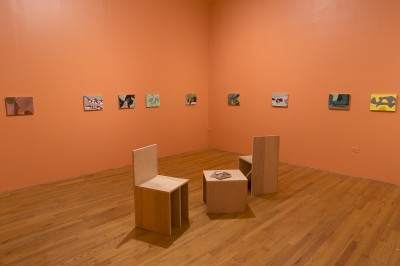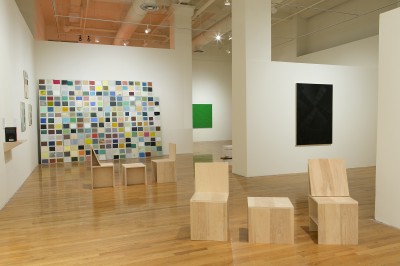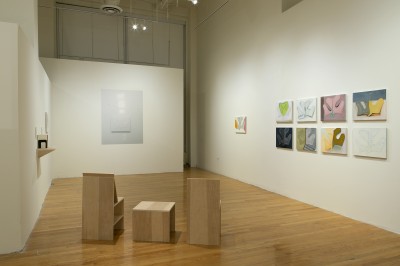“Slow Read” at Glass Curtain Gallery Inspires a Laid-Back Engagement

Time is a rare commodity, but a visit to “Slow Read” at Columbia College Chicago’s Glass Curtain Gallery inspires leisurely delay in even the most harried of circumstances. Showing until November 2, the exhibition brings a level of novelty to the gallery experience. It presents the works of five Chicago painters with each body of work flanked by shelves of books curated by the artists themselves. The selected books both perplex and intrigue the viewer, raising as many questions about the artist’s meaning as they appear to answer.
The idea that viewers should “slow down” as they move through a gallery is the driving concept behind the show. As a part of Columbia’s “Student Powered Spaces,” it is fitting that Glass Curtain has transformed itself into a space that reads much more like a library than a traditional gallery. Simple plywood chairs and end tables are scattered throughout the interior, reminiscent of cheap Ikea furniture that would look perfectly at home in any college dorm room. Books are shelved adjacent to the artist’s work while others are arranged on the end tables as carefully as a bookstore display window.

All of the paintings featured in the show are abstract, making the inclusion of the literature that inspired them all the more compelling. Surprisingly, artist Emiliano Cerna-Rios has read none of the books in his selection, but he feels that all of them conceptually represent his work. His very obviously unread choices, all fresh off the shelves of the local Barnes and Noble, contrasted with the well-worn tomes presented by other artists. A glance at the circus revelers dancing across the cover of Rabelais’s “Gargantua and Pantagruel” dissolves some of the abstraction surrounding Cerna-Rios’ vast canvas of color swatches.
Literary aficionados, analysis addicts, or anyone who simply enjoys solving a puzzle are sure to be delighted by these kind of “reveals” that “Slow Read” offers its viewers through the inclusion of artist-curated books. The conclusions that viewers can draw are endless. The artist statements provide some clues, but many of the connections are left up to the reader to decide.
With the exception of Cerna-Rios, the majority of the artists featured in “Slow Read” selected books that they were already well acquainted with. Magalie Guerin presented the journals of Anaïs Nin as part of the inspiration behind her collection. Guerin’s work distinguished itself from that of the other artists by repeating the same imagined shape reminiscent of a cloverleaf exposed to radioactivity in every one of her paintings. The wonder of Guerin’s work stems from the different images she is able to evoke from the same basic shape on nearly identical sized canvases.

Ears, antique furniture, and illusions of geometric rooms all flow from her manipulations of one organic shape. While her art intrigues by itself, it gains considerable depth through her inclusion of the diaries. “Even in the context of diary writing…the line between fiction and reality is shaky,” explains Guerin in an artist statement. Her fixation on the line between truth and fiction offers an unexpected context for her depiction of the various guises that the same fundamental idea can take. This sense of revelation and voyeuristic insight about the artists’ work is the biggest success of “Slow Read.”
At its core, “Slow Read” is a leisurely experience. Set in an open room littered with chairs, it does not impose the sense of exhaustion that sometimes accompanies other gallery and museum settings. Burnt-out tourists hunched over their smartphones on the only available bench are not part of this equation. The structure and curatorial choices of the space itself encourages the viewer to frequently stop and sit next to the art in question. Repeat visits are easy to slip into, especially when tempted by irresistible offerings such as Cesar Aira’s “How I Became A Nun.” This cannot be conquered in one visit and extends a subtle invitation for visitors to return for a long, slow read.





